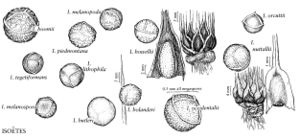Isoëtes melanospora
Trans. Acad. Sci. St. Louis 3: 395. 1877.
Plants becoming terrestrial. Rootstock nearly globose, 2-lobed. Leaves deciduous, bright green, pale toward base, spirally arranged, to 7 cm, pliant, gradually tapering to tip. Velum covering entire sporangium. Sporangium wall unpigmented. Megaspores gray to black, 350–480 μm diam., tuberculate with distinct to confluent tubercles; girdle obscure. Microspores brown in mass, 26–31 μm, smooth to papillose. 2n = 22.
Habitat: Shallow depressions on granite outcrops
Discussion
A population of plants in which the individuals have a velum incompletely covering the sporangium, a brown-pigmented sporangium wall, and dark brown megaspores occurs in Lancaster County, South Carolina.
These plants appear to be transitional between Isoëtes melanospora and I. virginica.
Plants of Isoëtes melanospora and I. tegetiformans typically grow actively after fall and winter precipitation. New leaves can appear a few days after the soil becomes saturated by rain, but normally they shrivel and disappear during summer when the soil dries.
Of conservation concern.
Selected References
None.

